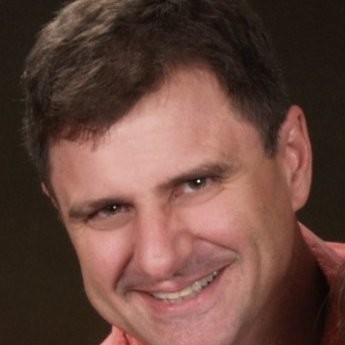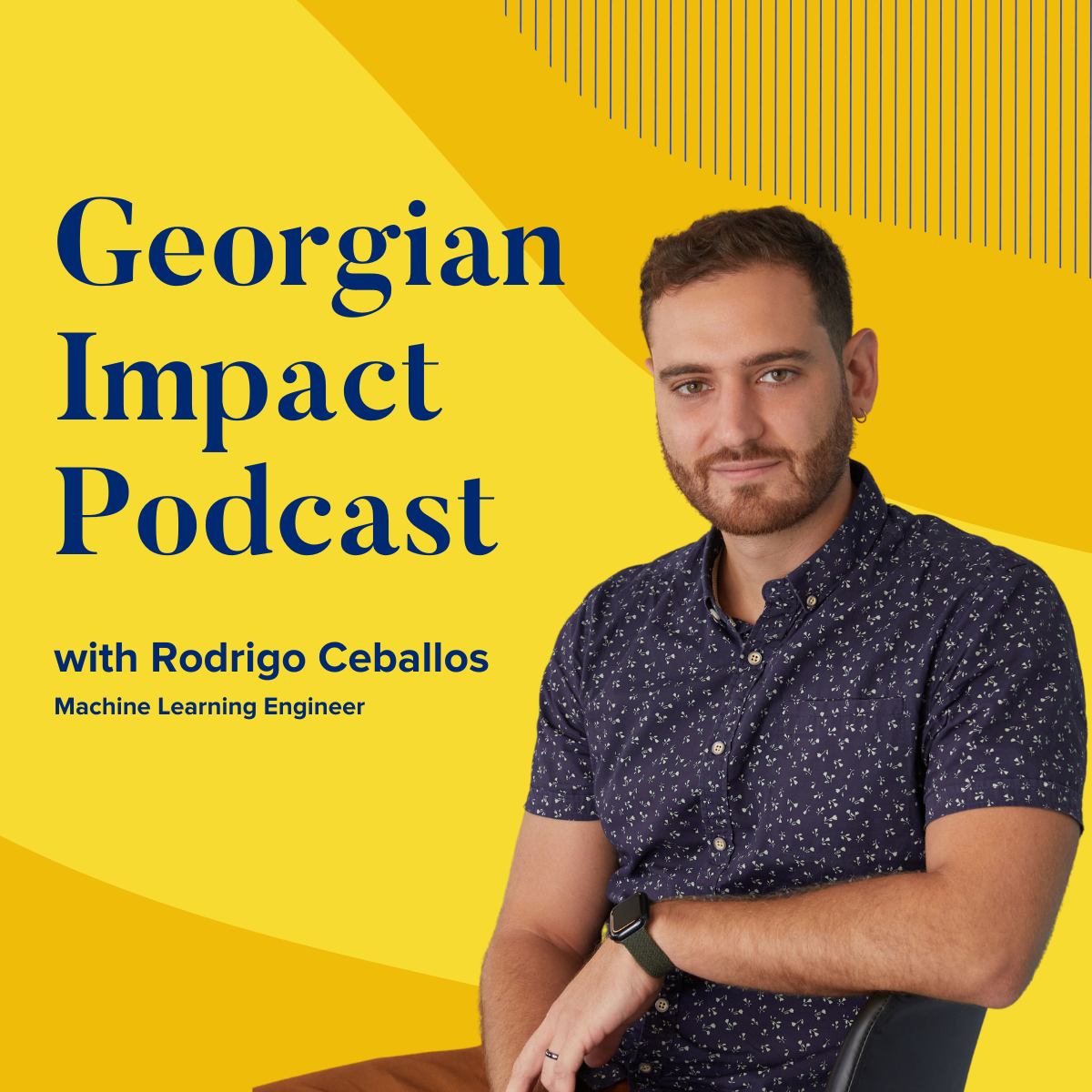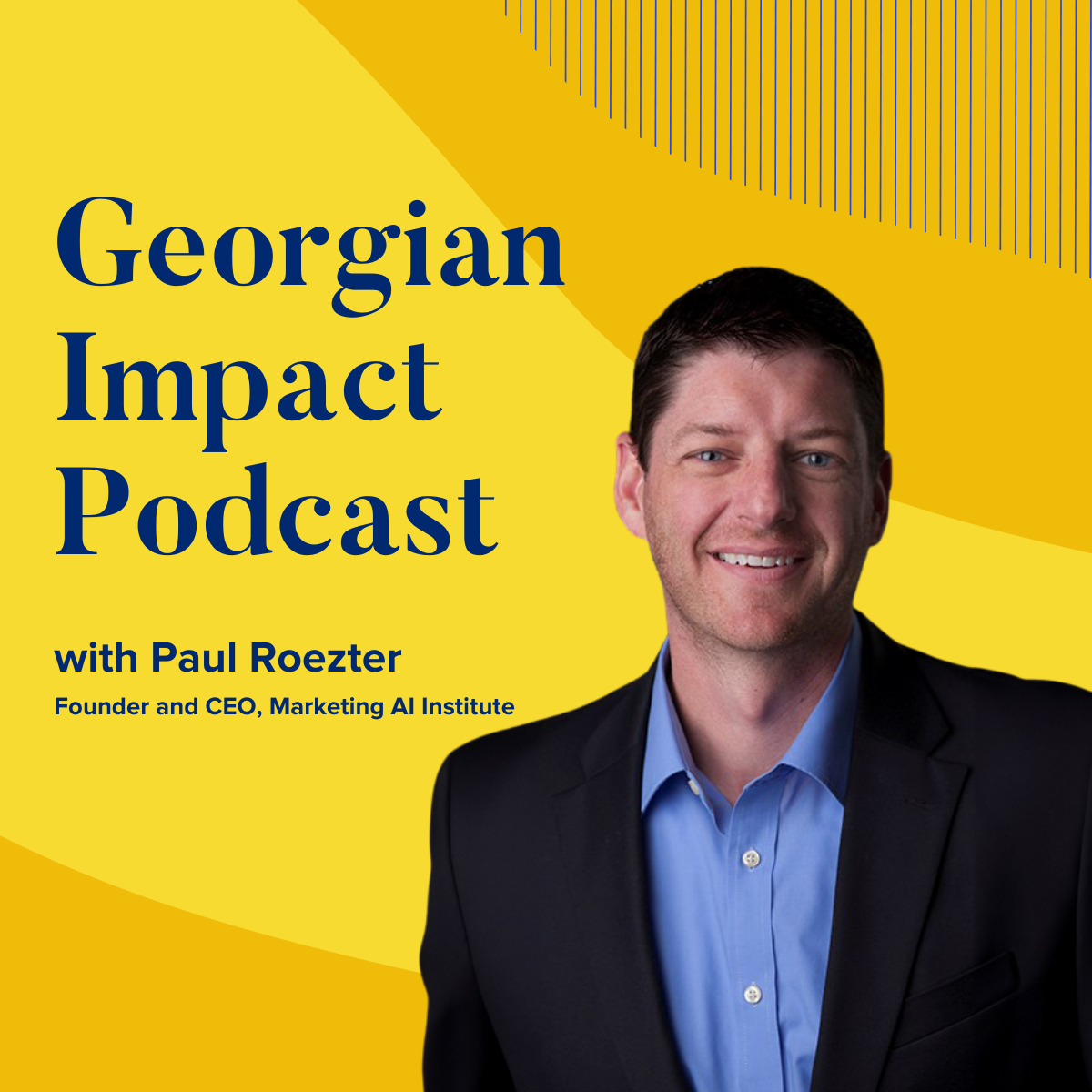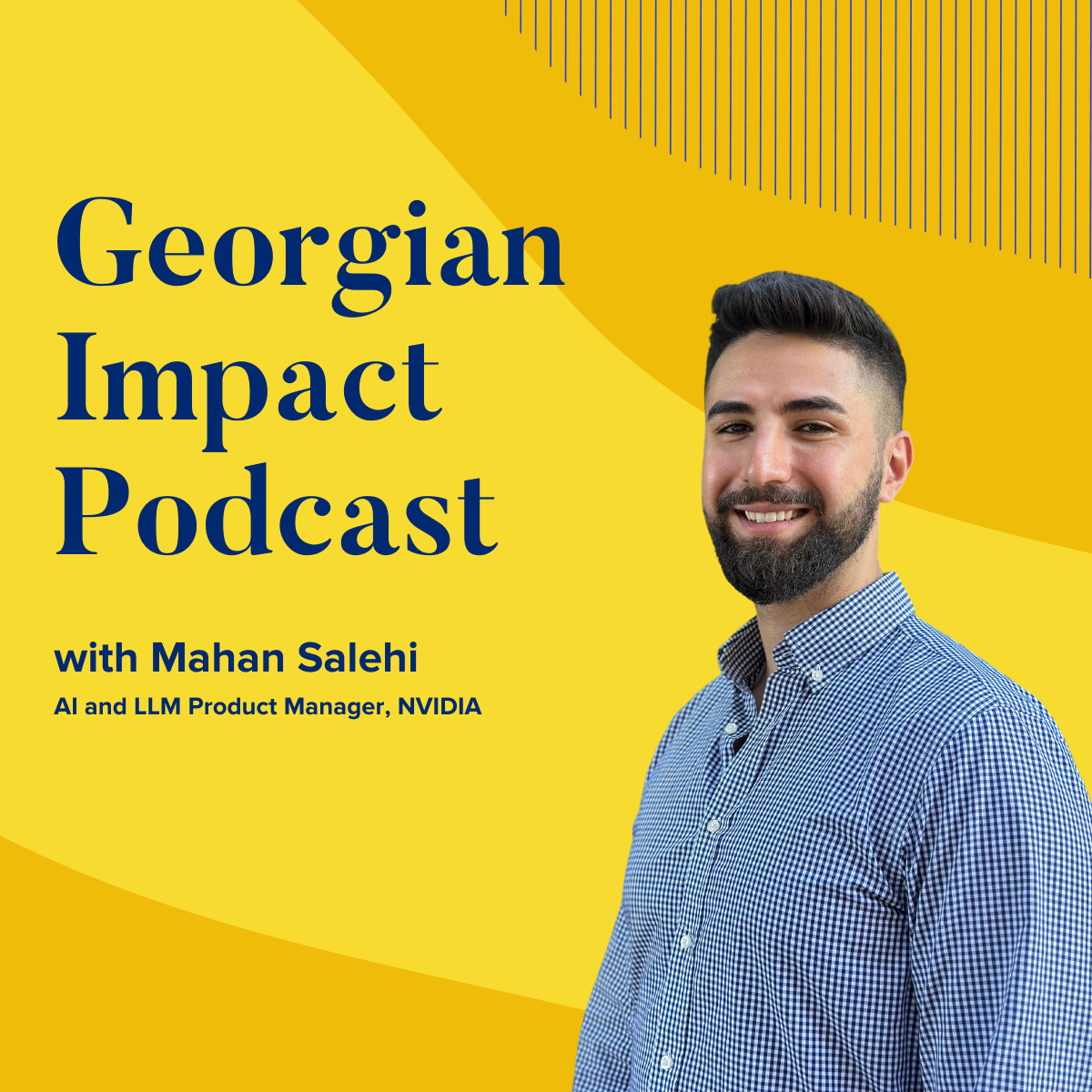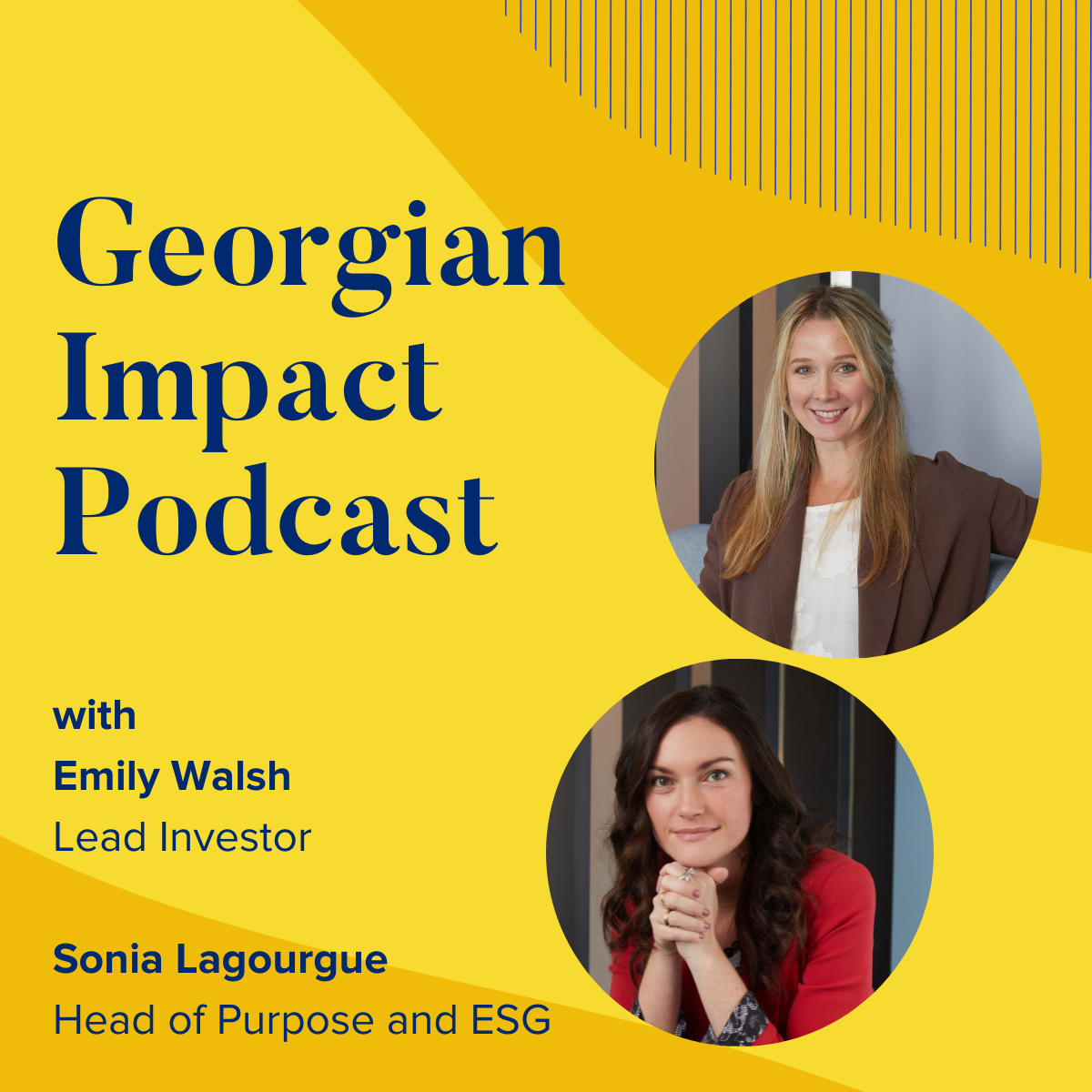Driving Digital Transformation using IoT and AI with Rob Rastovich
- 0.5
- 1
- 1.25
- 1.5
- 1.75
- 2
John Prial: Have we ever had a pandemic before? Yes. Have we ever had a financial crisis before? You bet. Have we learned from the past? Let's not go there. With the right focus, history can inform us today. You find the parallels. And with my Georgian hat on, thinking back can help you know your market, know your customers and your potential customers. Today, we're going to talk with Rob Rastovich, CTO of ThingLogix. ThingLogix focuses on the internet of things, bringing IoT together with a new generation of cloud tech, including serverless cloud computing and AI driving digital transformation across many industries. We're going to start with a bit of tech history, take you from the personal computer to the internet of things. It's worth it. They'll also be a parallel with CRM. Stick with me, this history is important. Now, if you're starting a business, where should you focus? What's known and unknown? Well, today we're going to find some parallels to get to some real world solutions around IoT, understanding ML and AI, understanding biases and helping you understand more about your own business. I'm John Prial and welcome to Georgian's Impact podcast. Now Rob, look, you were doing internet eCommerce in 1991. You've done development for large scale enterprise solutions, Salesforce and eight, yes, that's eight years ago you've been working with the internet of things. To me, your evolution epitomizes our industry. Why don't you talk to me of problems that you were solving back then and then what problems you need to be solving today and the similarities, if you don't mind.
Rob Rastovich: The very big first IT problem that we had, I was doing eCommerce back in the late nineties when eCommerce was first. eCommerce really took off, the dotcom boom was the late nineties, 93. I'll never forget it. I was working for a company, Harbor Freight Tools. They're a national retailer of tools. And I said," I've heard about this thing called the internet and I want to put up a webpage to sell tools online." And at that time, the owner, we used to get these great big green bar reports, I'm sure you're familiar with the green bar reports.
John Prial: Of course, tear off the holes on the side.
Rob Rastovich: Yep, exactly. He had a big one that he had a big report that he did and he threw it on his desk. And he says," I want you to look on page 112." And it says, I looked on there and it says," Percentage of customers that own a computer, two." He goes," No one is going to buy tools on the internet. Our customers don't even own a computer. What makes you think?" And I said," Well, because 98% of your non- customers do own a computer." I go," And are the people that we want to get start buying them."
John Prial: Played, well played.
Rob Rastovich: He says," Okay." He goes," You can have," there was an old computer sitting in the corner and he goes," you get one year and if you can make$ 5, 000 a month, then for three consecutive months, I'll give you another year." I had to do the whole thing. I had to provision the T1 line. I had to do the routing on the routers. I had to figure out what a DNS was. I had to put the DNS tables in. We had to buy domains. We had to figure out everything that goes in that entire thing. And that, we're really on the edge. And we ended up, eCommerce went up and I did$ 5, 000 a month in my second month and it grew from there and obviously was a big success. It still is a big success to this day.
John Prial: How did you find the customers? This is so early, there was no advertising. Maybe we shouldn't be going down memory lane, but let's stay there for a while. How did you actually find the customers?
Rob Rastovich: Our bread and butter at the time was a mail order business. We were a direct mail order catalog company.
John Prial: Bingo.
Rob Rastovich: I just said just at the bottom of the catalog, I want harborfreight. com, just put harborfreight. com on there. And it was novel enough back then that any time somebody saw something, oh, we can go to that dotcom and oh, look, we can pull it, we can see a picture of the tool and we can see a description. But IoT was very similar to that. We were talking earlier and this was 2006, 2008, 2009, something like that or the idea came up with was what if we could have a thermostat that could talk to a temperature sensor and it could automatically connect those two things? Or what if your car could actually talk and you could know where it's at and all those types of stuff? We thought, well, this is what I want to do. And that was the crack cocaine. And once I started seeing machines talking to machines, we had to build the whole infrastructure again. We had to start out that whole process because none of that exists. What we ended up doing is we started a company called 2lemetry, me and about four or five of my buddies from when we were doing after the Salesforce gigs. And we wanted to build a piece of technology that could ingest millions and millions of pieces of data simultaneously through socket connections. And our goal was to sell it to Salesforce because we thought Salesforce was going to use this. And we thought IoT was the next big thing. And we thought that if we could build this up, Salesforce would buy it and that would be it.
John Prial: Interesting to think that CRM would be the first target app for these for the IoT, interesting.
Rob Rastovich: And what you brought up earlier was it was only because of relationships. We had just spent eight years doing Salesforce implementations and delivering. We thought, okay, well, they're the next hot thing so they could do this. Anyway, we had to prove out our stuff. We had to prove out the fact that we could do this. We spun up just hundreds of EC2 instances on Amazon in order to make all these connections. And then we spun up hundreds more of them to hit those other 100 that we had so that we could do a stress test on our technology. And we got a call from Amazon and said," Stop that. What are you guys doing?" And so Amazon got interested in what we were doing and long story short, that technology which we had at 2lemetry, we sold to Amazon and is today what is known as AWS IoT. And so that broker that became the core of AWS IoT, because it was kind of our, ThingLogix was born out of the idea that, all right, we need to provide professional services. We need to provide ways and solutions to help people solution on how to actually do an IoT solution. What is it?
John Prial: Let me back up, you're talking about services. Little bit of history, there you are spending how many months building from bare bones and chewing gum and DNS connections, you're building the app. And now I could build this website with drag and drop, no code, we love these words, no code, low code. I can go to any website builder, there's dozens of them and build it up. And so, 20 years later magic has happened. How far has the magic happened in the world of no code IoT?
Rob Rastovich: And ThingLogix was born out of the technology that we sold to Amazon, nobody had the ability to do these kinds of things. And we thought, okay, what Salesforce did for CRM, I'm sure Benioff and Parker Harris were sitting around one day and they said," You know what? Everybody needs accounts, contacts and leads and opportunities. And everybody's going to make a database and they're going to have first name and last name and email address and phone number. Why don't we just give them all that and have everybody start at the same spot and then they can customize from there?" Same thing because of that DNA, we thought IoT solutions are the same thing. You need asset management, you need history check. You need to build it to put logic against your devices. You need to be able to understand what the context of a devices you need to provision and deprovision a device, all this stuff that have to go into solution. Why don't we just build that and start day one with this whole bag of tricks that we can do and then build our solution on top of that?
John Prial: Is it the same bag? Name, address, telephone number, I get. That's the metadata of a customer. If I'm thinking about a thermostat versus a, I don't know, a solar panel versus a remotely controlled water bottle, but I don't know. I guess there's on and off. And I guess there's identification. What else? What's the commonality across an IoT device?
Rob Rastovich: The only commonality is that they talk, that's it. They all talk a different language. Well, we talk MQTT primarily, but they all have different attributes. They all talk and that's why the system has to be able, any system has to be able to dynamically provision those stuff and keep the history. You don't have time in an IoT world to go, okay, well let's see. We're going to make a field in a database and it's going to involve this. It's happening on the fly, it's happening all the time so you got to auto provision fields and devices immediately.
John Prial: You mentioned time and this is something that's always been in my, whenever you hear the talk about 5G and I'm not watching a movie on my phone, but everyone says that 5G is the greatest enabler of IoT devices because of the volume of devices and the speed. Is that true? Do you feel that what's going to happen that's a game changer?
Rob Rastovich: Well, I think that's the hope. IoT devices, the payloads are very small and the speed isn't as much as a requirement as it is reliability. If I'm a temperature sensor and it takes me three seconds to get the temperature versus one second, I'm going to get one every three seconds and I can take action. Now, if I'm in a Tesla and I see a car ahead of me and it needs to hit the brakes, then speed becomes a little bit more of an issue. But in that case, that's more localized, IoT is machines talking to machines at the local on prem level. They're not going up to the cloud.
John Prial: Latency would be, just there's local and remote latency so to speak.
Rob Rastovich: Yeah, exactly. Yeah. You certainly don't want your Teslas determine whether it should hit the brakes or not going up to the cloud and determine if the cloud is coming back. I do think 5G is definitely going to help in terms of its IoT devices in terms of the cost too, because I think these carriers are starting to get these much smaller plans and they understand IoT that we don't need a big plan. I just need a little bit of data and then, so I do see some of them coming out with that. And they've been around for a while though.
John Prial: That's interesting. It's$ 10 a month for your connectivity on your Tesla and the biggest benefit is if you're parked watching Netflix, but who cares? Just charge me 50 cents a month and set the data up. That's interesting. We kind of did the analogy of website builders and to the IoT builders. One of the challenges as I think about into this, and there is a difference between no code and low code in terms of how you build logic. Website builders are trivial and people could do that. If you need to start doing decision making at the backend that I guess could be called low code. And there are companies that are beginning to do that, but even that's not in my mind as an old guy, traditional programming. What's your view? We'll stay on the back end before we move the front end. What's your view on kind of the backend tools and how that gets pulled together?
Rob Rastovich: We really kind of focused on the back end when we started, because as I'm a traditional consultant and delivery person. I walk into a client. Customer says," These are the problems that I have. This is what I need to solve." Usually, as a technical architect, you start thinking, okay, first thing you start thinking is data. Where's the data? How do you get to it? We have a mantra, real data real fast. Then the next question is, okay, I've got to write some code. Where do I put that? Where do I install my code? In websites and stuff, we know, oh, the servers over there it goes to that server, I put the code on that server. In IoT, there is no server to go. You kind of have to have your code in line if you will. One of the things that we built very early on was that exact logic, the ability, which is actually where the name of the company came from, ThingLogix, was we needed a place to put the logic for our things. And so we built this framework using the AWS serverless resources to put logic in line in an event driven place. You can write your custom code. We obviously have hundreds and hundreds of lines of code and lambda functions that come with our solution but we give you as much of a framework on how to do a IoT solution as we do provide products and services.
John Prial: And so, I always viewed that there's systems, people that write systems and then there are people that kind of write applications. You're doing the systems and a little bit of application logic layer so that someone could really just focus on building a functioning app, is that a fair characterization?
Rob Rastovich: Yeah, exactly. We take care of all that underlying stuff that gets in the way of building an application. Again, to go back to the Salesforce analogy, if the CTO comes down one day and says," I want you to build me a CRM." Well, all the IT guys start thinking, okay, I got to get a database. And so I need a DBA, which database am I going to install? I'm going to use Java as my thing. All right so I got to figure out servlet versions. I need an application server and then I probably have to have load balancing. Ah, Salesforce just said," here, go do this." We'll take care of all that system level stuff. We take care of your security and your user management, your asset provisioning. We give you the framework, but what you need to focus on now is here, start this. Now, what's the application you want to build? What is the solution that we're trying to provide here? And lets you focus on that. And so on day one, you actually get to start building something of value as opposed to having to trudge through all that system level kind of stuff, to get to really the fun part of IT is building applications.
John Prial: What about, it's a horrible story, I was a huge fan of Mr. Robot and they hacked the Raspberry PI and made this thermostat blow up. What's your view of building security into what you've got or what the device has? All the hardest stories of the rings with admin and passwords and BlackBerry they hacked the coffee pot. What's your view of how that gets done? And how do we protect? And how to companies build kind of a foundation of trust for their customers?
Rob Rastovich: Yeah. Obviously we have spent a great deal of time not only pondering, but validating. We've been through a number of security audits, always constantly updating what we consider to be best practices too, because I think a lot of times what's best practices is still being invented in this area a little bit. And unfortunately you get a lot of this and I remember the story, there was a guy in a hotel room. He was able to log in, get access and start turning the lights on and off in all the other rooms. There's another story about somebody, they had a rental car where the app was used to start the rental car, when they got out into where there was no cell service, his car died and they couldn't start the rental car because there was no cell service.
John Prial: Of course, of course, of course.
Rob Rastovich: But we do have a couple banks that use our products that we've been through those security audits, but keeping security and monitoring that is of paramount importance. One of the foundational tenets of that is what used to happen kind of in the IoT world is we would say," Okay, here's a bunch of devices. Let's connect them all to the server." Now we really think of them as authenticated individuals, just as somebody has to authenticate, you have to authenticate to get into your bank. You have to authenticate to do this. Every single device has to go through that type of authentication. And they're not just a group of things anymore. They have to be treated as individuals and you have to monitor what each individual device is and then there's stuff that sits in front of that that looks for suspicious behavior. And then you can turn off individual devices. When we first started this years ago, it's like, okay, well we have a breach, you turn off everything. And that just doesn't work anymore. Being able to authenticate each individual device, being able to know when a device can turn it on, turn it off, monitor it as if it were the only thing on your network. That's definitely the direction of our security paradigm. And every time I see a story, I got to cringe a little bit and you dive into it and see what happened. 90% of the time it's not the tech in the device, it's the human error.
John Prial: So sad, so true.
Rob Rastovich: Leaving these doors open. Somebody left the door unlocked and left the keys in the car and somebody stole it.
John Prial: You have a wide variety of applications. Now, at least I understand why you have a device management piece of ThingLogix, because obviously you're authenticating and tracking. It's kind of just, it's almost the cost of doing business just to get started. But so I've got device management, we get the cloud, but it's not clear to me where and how you get, it's small amounts of payloads, small data coming back and forth, lots of different devices so help me understand how AI and IoT go together. Let's take this kind of to that ultimate step here.
Rob Rastovich: When everybody talks about IoT, I think they think what we call AI IoT. They think that these things should be smart, but I think the reality is IoT up to this point or until the last couple years has been connectivity. Can I get this? Can I have it connected? Can I see the data coming up? And I always say, there's a lifecycle to an IoT project. We walk in and somebody says," Okay, we want you to connect our stuff." All right. And we show them a feed. We say," Okay." We put the firmware on there and that device starts chatting and we show them a screen. We show the messages coming up. Oh, that's so cool. That's awesome. That's amazing. And then the next question is," Can you put it in a graph?" Ask if you can put it in a graph.
John Prial: I don't want just reporting solutions, please.
Rob Rastovich: I know. Well, we make a graph so they can see the temperature go up. Oh, that's amazing. Then they say," Oh, can you make it send me a text message when temperature gets above a 100?" Yeah.
John Prial: There you go.
Rob Rastovich: Okay. We can send you a text message. Then they get to the point, this is amazing. We're going to make a business out of this. And then they say," I want to connect 10, 000 of them." And then they have what I call the oh shit moment. Oh shit. Now what are we going to do? First thing they do, turn off the text message. Stop the graphs from going. We don't need to see that. Can you make that smart enough, instead of the temperature sensor sending it and seeing a graph or maybe it's a water sensor, instead of the water sensors telling me that there's water in the basement, can you make the water sensor smart enough to tell the pump to turn off? And the pump needs to be smart enough to tell the panel that it's turning itself off. That interconnectivity and I think a lot of times we think about AI as predictive stuff and we do that as well. But at the very basis is we need devices that are smart, that have intelligence. And in order to have intelligence, you have to have a place to put logic. You have to have some place where you can make the intelligence and put that intelligence in there. And that's really where I always say we have created a solution for a problem that most people don't know they have yet.
John Prial: There's basic logic if the water reaches a certain level, turn it off. That's programming and not necessarily AI yet. The next degree of AI takes it to where?
Rob Rastovich: Yeah. The next degree of AI takes it to the fact that you know there's going to be water in the basement because you have a device on the river that's way above where you're at that's monitoring the river and that device is going to talk all the way down and be able to predict models and say," What's going to happen to this water as it goes a 1, 000 miles downstream?" The easy part of AI and machine learning is the prediction. Getting the prediction is not that difficult because we have lots of algorithms and they're getting better and better all the time, which is a whole other discussion. And we won't go into the moral discussions of those algorithms, but they are getting better and better all the time to make the predictions provided that the data that they've been taught, that you have the ability to teach them, it's the teaching that's the difficult part. And one of the things that we have doing is given a framework so that devices have a mechanism to learn. Think about it like, all right, maybe we don't necessarily know the subject matter. Maybe we're not very good at math, but what we're going to do is we're going to provide the classroom so that the mathematician professor can teach the students how to do their stuff. We provide the infrastructure, the framework in order for that learning to happen. And that to me is in the next evolution of AI and machine learning. And this is the thing that everybody is I think sometimes worried about and should be worried about is what are the biases that go into the learning? What biases do we send to the learning to make them because all of us, even no matter what we do there at some point, there is a set of learning frameworks and guardrails that we will put and pass along. And the thing about the AI, they will regurgitate that verbatim all the time. And having that mechanism to go back and say," Okay, you got it close." And you got to get it close. It's a constant continue education units.
John Prial: You've got apps, you've obviously talked a little about the infrastructure, let's kind of go in the middle between the baseline infrastructure and some of the apps and some of the microservices you have. You do have an offering, which is kind of video and image analytics. That's very AIish to me. How low codeish is that? That's a new word.
Rob Rastovich: Yeah. We've taken a lot of that. We use video. In fact, video becomes kind of the easiest, most convenient way to deploy IoT. We use video with the USGS to monitor rivers and streams. We have actually have a camera that will take a picture of a set with in a stream and it can determine flow height to the water, how fast it's moving, those kinds of things, which then moves that stuff downstream to irrigation districts and other things down there. We obviously do recognition. We have a construction company that has thousands of workers showing up every day to a construction site. And instead of clocking in and clocking out, they just walk through the tunnel and it clocks them in, clocks them out. You can do recognition in that way. Other videos in just in counting. Maybe you're not needing to recognize who the person is, you don't have a reference on it, but being able to count. The people counting thing has been pretty popular during COVID. We have a store and it only has the capacity of X amount of people. Well, you could have somebody out there clicking, but with cameras, you can count people going in, you can count people going out and you can determine if they're adults or children, those kinds of things. The text recognition has also been in big demand because being able to take a photo and extract text out of it and be able to then take that text and act upon it. Document management, whether it's we have an application where kids show up to school, they scan a QR code to see if they can get in, make sure they've taken their health tests and those kinds of things. But all of those kinds of cameras become, and they're easy to put into kiosks so you can interact with them. That's by far the number one device, if you will, and most of those algorithms are really kind of plug and play these days. You want to do recognition of people coming in and out, it's an installable type of application. People counting is an installable application.
John Prial: Does it sit in your AI marketplace? You've got a marketplace on your site. Is it your code or is it third parties beginning to develop for you?
Rob Rastovich: We've actually developed a edge technology in conjunction with a couple partners. We do have an edge component to Foundry that, so if you take on the recognition, if you're going to take a photo of somebody, to send it up to the cloud and bring it back down to determine if it's a person, because in a video feed, you want to be able to distinguish between which in this picture is the person? It's not the bag over here and it's over here, so you don't want to have that going up. That edge technology will help analyze that, focus in on not only where the person is, but in the case of taking temperatures and thermal cameras, focus in right in between the eyes where the heat's going to be the best to all of that edge kind of stuff takes out there. But our whole application and it's a great question because our application actually installs for inside of your AWS account. We're a little bit different in the sense of you don't come to us and we have this application that you sign up for and it's ours and we manage it. We still manage it. We still take care of it, but we install it into your account so that it actually is yours.
John Prial: Rob, this was a fantastic discussion. I think we had a great journey from the beginning of time, well, beginning of computer time, all the way to AI and IoT. Rob Rastovich, CTO of ThingLogix, thanks so much for being with us today. This was fabulous.
Rob Rastovich: Thanks, John. I appreciate you having us.
DESCRIPTION
With the right focus, history can inform us today; you find the parallels. Thinking back can help you know your market, know your customers and potential customers. Rob Rastovich is our guest on this episode of the Georgian Impact Podcast. He is the CTO of ThingLogix and focuses on driving digital transformation across many industries using IoT and AI.
You’ll Hear About:
● Rob’s background with 2lemetry and its sale to Amazon.
● ThingLogix and their IoT services and solutions.
● The evolution of IoT services and the impact of 5G.
● Security and the growing importance of authentication.
● How IoT and AI work together.
● Uses of video as a microservice at ThingLogix.
Today's Host

Jon Prial
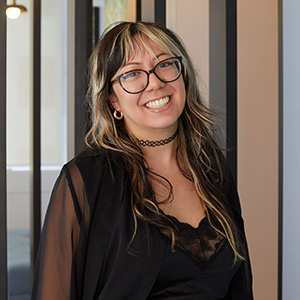
Jessica Galang
Today's Guests
